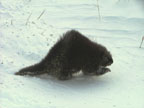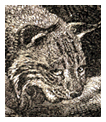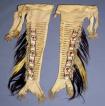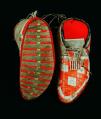

Some of the shed-sized boulders in the woods and on the lawns of the Finger Lakes region of central New York have been trucked downstate from Lewis County for people who cannot wait for the next glacial push, but some are genunine glacial eratics. Several times in the last eon, the global ice has ploughed right down into the present Tompkins County, piling up ahead of it a range of hills composed mostly of material removed from the north country.
As the last glacier dropped its load and shrank back to the Canadian shield, forests were already maturing in the lowlands, and the bared rock of the Adirondack highlands began to gather moss.
In the era before much soil accuulated on the bedrock of the granite shield and a piney forest began to creep up on the moss, some travelers would have visited here, not just for the mineral attractions, but for the animal products of the still relatively open borderlands: particularly Elk, moose, and wood bison. One of these big meat animals could outweigh half a dozen whitetail deer, and smoked down to jerkey, could supply a kin group for a month. Besides their being a lot more meat to a moose or an elk, the thicker hide of the larger animals was necessary to make the soles of any moccasins that would last on the trail.
In the boreal highlands the hunters would also have found the greater weasels: otter, fisher, martin, and mink, if not also wolverine, which seems to be half weasel and half bear: a creature you would not want close to home, but whose fur is invaluable close to your face, as frost tends not to accumlate on it so much as it does on other furs.
Because of the poor soil here, it seems unlikely that any Indian peoples who camped and foraged around Lake Bonaparte ever actually settled up here. This is the country of snow and flies, the provence of the beaver and of the porcupine. Beaver would not have been much of a draw here, because they were common in the lowlands as well as up north and, before the European felt hat suppliers began demanding them, were as likely to be claimed as family and valued for their waterworks as for their furs.
Pound for pound the most valuable commodity from up here (until the Europeans stole the market with glass beads) might well have been porcupine quills.
In the Finger Lakes country porcupine quills were as rare as sea shells , and, being hollow, were at the same time very light weight, portable, durable, and attractve as ready made beads for decorative applications.
The porcupine does not respect squatters rights in his territory, and is an amoral landlord who will treat your woodshed like his kitchen, will eat not only ornamental evergreens in bud, but also your boots, salty tool handles, and maybe even your car tires and your plastic garbage cans. Plus, he will occasionally be the death of dogs, especially of irrepressible hounds who don't learn at first encounter.
The porcupine is a natural resource, a nuisance, and to some, a devil, but he is also a kind of sacred pig. Both red and white hunting lore have it that a wilderness traveler does not kill porcupines. Like skunks, porcupines are over confident of their defense system, so you can easily kill one with a stick. As long as porcupines waddle the wilds, there will always be something for a human lost in the woods to eat.
At loon Island, we have tolerated the porcupines. During a few years recently, a lone porky summered in the hemlocks on the west side of Loon Island, and wintered in the crawl space under our camp without most of us people, or even the dogs noticing. For three days and nights one May, he hunched like a giant pine cone near the top of a twenty foot cedar right out side the kitchen window. I don't think he had anything at all on his mind, but it felt like a stand off.
Anyway, in order to make a living, I had to yield the territory and go back down to Ithaca the next day.
It has always been hard to make a living up here, but having examined the Bonaparte Cave Stone, I figure that in the early middle post glacial period, your ideal, lean opportunist could come here in October with nothing but corn and flint, and in Feburary, pull out a toboggan piled with fur and jerkey, plus maybe big bag of quills ballasted with lead, a pretty bit of feldspar, a few magic crystals, and a handfull of mica sunglasses in the making.
Or a young man of another sort, maybe or less like you or me, might come here to kill a bear for the meat, the lard, for the noteriety, and more particularly, to capture it's soul.
While the bear skull boiled and the lard was rendered, he might sit in the skin on the bluff where our chimney is now. He would blow some smoke up to the Great Bear constelation of stars and hold his breath for a vision.
Bears still in their own skins are too large to hesitate at Loon Island, although they have always been around us, know all about us, and want nothing to do with us
There are talus caves in the hills where you might expect bears to den, but what you are likely to find there is the common porcupines again, or more often and their piled high guano.
Bears actually require less space in which to den, and they are mostly inactive during the winter, whereas the porcupines are more festive and communal in winter and will wander about, sit in trees and eat in all months, and then return to the cave to groom and defecate, as can be seen: tightly layed beds of little pine duds.
An Indian friend tells us that Onondagas still return to a traditional porcupine denning site near Lake Bonaparte to collect shed quills. The quill hunters, I am told, do not believe in killing porcupines for this purpose. Nor would it be necessary, as there are so many of them to be had as road kill on route three.
The porupine is dead. But we have his quills. Long live the porcupine!








Before felt hats became fashionable in Europe and the Hudson Bay compay and others turned the Indians into a supply source some small Indian communties, no doubt headed by the powerful beaver Clan, had lived right on the ponds with the the beavers and considered them to be little brothers. In the late nineteenth century when the beavers and the Indians were mostly gone, a white trading company brought in a team of Canadian Algonquins to trap out the last of the beaver on the upper Oswegatchie a few miles from Bonaparte.
Before they were extensively trapped, it is likely that mature specimns got to be larger than what we see now days, and it has been discovered in the fossil evidence that beavers of the Pleistocene era got to be as large as five hundred pounds. Such a bear-sized beaver could make a house the size of barn and a lake the size of Bonaparte.
According to my half- wild, and somewhat fanciful brother William, beavers often lived to grow as large as people well up until the seventeenth ceuntry. And (according to William) the people commonly lived with the beavers actually in the beaver houses. I don't know how he can be assured of this, but I know that William himself actually went through two winters in beaver lodges back on the Fort Drum military reservation.
The hemlocks lately have been more damaged by an invasion of beetles than by the quill pig.
The beaver, the deer, moose, fisher, lynx and other aborignal wild residents, once eradicated, have all returned to some extent, and the beaver have completely recolonized all the way from the back country to inside of our boathouse, but we do not expect to see the wood bison here again. Indians fleeing westard in advance of the white invasion, pushed the bison ahead of them and clear out onto the prarie where they would later be chased down by trains.




Beginning
